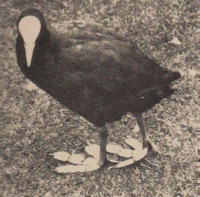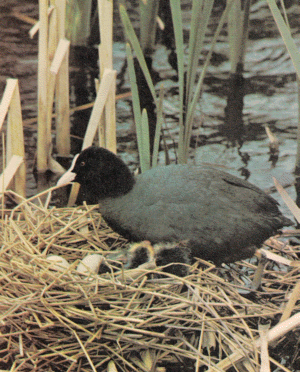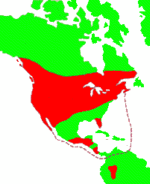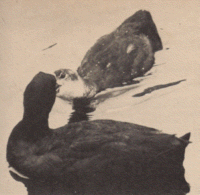 SKC Films Library SKC Films Library |
| |
| SKC Films Library
> Science > Zoology > Birds > Order
Gruiformes |
  American Coot American CootFulica americana Description Coots are similar to ducks in general appearance, except that coots have lobed feet (see picture at left) while ducks have webbed feet. Those lobes make the coot a powerful swimmer, but also allow it walk easily on land, while ducks have some difficulty on land. Coots can also be distinguished from ducks by their short, round wings. While the coot can fly, it must get a running start across the water before it can take off, while the more streamlined wings of ducks allow them to take off with little effort. The American coot is about 15 inches long, has a wingspan of 22-28 inches, and weighs about 32 ounces. It is gray overall, with a patch of white feathers under the tail and a white shield on the head. The bill is white, with red swelling along the upper edge.
American coots can be found throughout much of the contiguous United States and southern Canada, from Maine and New Brunswick west to the Pacific Coast. Some populations migrate in the winter and can be found in Florida, Central America, and even into South America. They live on the edges of freshwater lakes, ponds and marshes, prefering areas with plenty of reed cover. Diet Coots feed primarily on vegetation, but will also take small aquatic animals, insects, and even the occasional stolen egg. Most food is brought up from the lake/pond bottom, with the coot diving down to grab a clump of vegetation and then bringing that clump to the surface to be sorted through for edible bits. Coots can dive to a depth of up to two feet and stay under for up to 30 seconds.
The breeding season in most areas runs from May through June. Both sexes engage in ritual displays to attract mates, but it is unknown which, if either, sex makes the ultimate decision to pair with a specific mate. The mating itself begins on the water and ends on the land. Once mating is completed both parents work to build a nest, which is almost always placed within vegetation at the edge of the lake or pond. The nest itself is constructed out of dead reeds and leaves and will ultimately rise one or more feet above water level, with a ramp leading from the nest interior to the water. Clutches usually consist of 8-10 eggs, which are pink with brown spots. Both parents incubate and guard the eggs throughout the 23-24 day incubation period. They also share in the feeding and care of the chicks, which can begin diving for their own food at about one month. Fledging takes place at 5-8 weeks, and the young are fully independent once their feathers are fully developed. The average lifespan of an American coot in the wild is about 9 years. Other Habits and Behaviors Coots are the only members of the rail family to live in flocks, which can number into the hundreds. They are very vocal birds, using a variety of grunts, clucks and other noises to communicate with each other and ward off predators. Scientific Classification phylum Chordata PRINT SOURCE INTERNET SOURCE |
SKC Films Library > Science > Zoology > Birds > Order Gruiformes This page was last updated on January 14, 2017. |
 Distribution
and Habitat
Distribution
and Habitat Reproduction
Reproduction